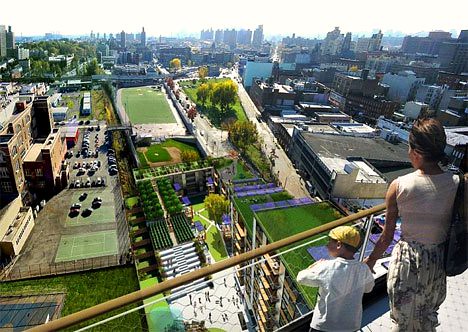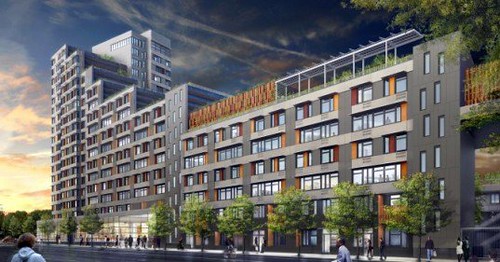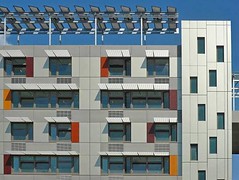The spectacular 'green way' to build affordable housing

Posted October 13, 2011 at 1:40PM
Via Verde (“Green Way” in Spanish) is a new mixed-income, mixed-use development nearing completion in a once-severely disinvested area of the South Bronx. It will provide affordable housing, but it is like no other affordable housing development you have seen. It is much, much better.
First, the basics: Via Verde will provide 151 rental apartments affordable to qualifying low-income households and 71 co-op ownership units affordable to middle-income households. The latter comprise a diversity of types including single-family townhomes, duplex units, and live-work units with a first floor work/office space. There will also be 9,500 square feet of retail and community space. The 1.5-acre site is in the Melrose neighborhood (near another wonderful project, the LEED-ND-certified Melrose Commons) with access to mass transit and other urban amenities.
What makes the project noteworthy is that the architectural and development team is creating a distinctively innovative approach to green and healthy urban living: this begins with a spectacular stepped architectural form that will create 40,000 square feet (roughly an acre) of resident-accessible green rooftop terraces at varying heights. Intended to integrate nature with the city, the rooftops will provide functioning green infrastructure that can harvest rainwater, grow fruits and vegetables, and provide open space for residents. The garden level in particular is intended to provide both an organizing architectural element and "a spiritual identity for the community," according to the Rose Companies' web site.
Other amenities that contribute to the project’s theme of healthy living include open air courtyards; a health education and wellness center proposed to be operated by Montefiore Medical Center; health-oriented retail space; a fitness center; and bicycle storage areas.
Writing in The New York Times, Michael Kimmelman praised the project:
“The rebirth of the South Bronx isn’t news. But Via Verde is. And it makes as good an argument as any new building in the city for the cultural and civic value of architecture. The profession, or in any case much talk about it, has been fixated for too long on brand-name luxury objects and buildings as sculptures instead of attending to the richer, broader, more urgent vein of public policy and community engagement, in which aesthetics play a part.
“Via Verde helps shift the conversation. Like all good architecture, it is handsome. Unlike too much, it goes out of its way to be healthy.”
Kimmelman points out that asthma rates are high in the South Bronx, access to healthy food and wellness amenities limited at best. After meeting with neighborhood residents, the team took pains to address these needs. I have been following the project for several years now and, in my humble opinion, they have done so spectacularly.
Beyond health benefits, Via Verde is also designed to exceed LEED Gold standards for building energy and performance. Along with the green roofs, which will provide natural cooling in warm weather, the project will utilize low-tech strategies like cross ventilation, solar shading, and smart material choices, along with more tech-based strategies such as photovoltaic panels, high-efficiency mechanical systems, and energy-conserving appliances.
In one particularly innovative measure, the building's design places some of the solar panels on the side of the building, not the roof as is customary; others are placed on canopies that provide shade for the garden areas. As a result, the roofs remain free for green space. The firm Bright Power, which consulted on the project, has a good summary of Via Verde's energy efficiency and green building features on its website.
The project is being built by co-developers Phipps Houses and Jonathan Rose Companies, in partnership with Dattner Architects and Grimshaw Architects, pursuant to a commission won via the New Housing New York Legacy Competition. That competition was specifically intended to “re-engage design with the issue of affordable housing,” as former New York Housing Commissioner (and now HUD Secretary) Shaun Donovan told Kimmelman. The Times writer is impressed with the design results:
“Higher costs for green construction have, over recent years, come to be accepted as investments in long-term savings. But spending extra for anything as intangible as elegance or architectural distinction? In Via Verde’s case maybe 5 percent more, by Mr. Rose’s estimate, went into the project’s roof and its fine, multipanel, multicolor facade, with big windows, sunshades and balconies. What is the value of architectural distinction? How, morally speaking, can it be weighed against the need for homes?
“In terms of equitability and self-worth Via Verde does more than just aim to provide decent housing that fits noiselessly into its neighborhood. It aims to stand out, aesthetically, formally, as a foreground building, not another background one: to anchor the urban hodgepodge around it and make the area look more coherent, which in this case entails not echoing its context but redefining it. What is that worth? . . .
“[A]rchitecture doesn’t solve unemployment or poverty, and neighborhoods rise or fall as decent places to live on the quality of their background buildings, which do and should predominate. But they’re distinguished by their landmarks, by the buildings and places that people come to love.
“The greenest and most economical architecture is ultimately the architecture that is preserved because it’s cherished. Bad designs, demolished after 20 years, as so many ill-conceived housing projects have been, are the costliest propositions in the end.”
That is very good thinking and very good writing (In the bolded portion, it channels Steve Mouzon's sustainability philosophy). But perhaps the most eloquent observation of all was provided by Bronx Borough President Ruben Diaz Jr.: “Let it be known that, where the Bronx once burned, we are building gardens in the sky.”
Via Verde’s landscape architecture is being provided by Lee Weintraub, and construction is being managed by Lettire Construction. Occupancy will begin this winter.
Move your cursor over the images for credit information.



